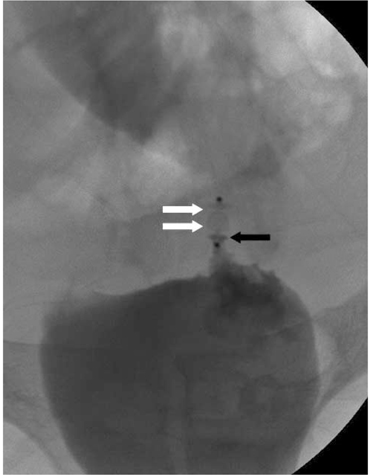J Korean Soc Radiol.
2011 Apr;64(4):325-328. 10.3348/jksr.2011.64.4.325.
Percutaneous Treatment of a Jejunovaginal Fistula Using a Combination of the Amplatzer Vascular Plug II and N-Butyl-2-Cyanoacrylate: A Case Report
- Affiliations
-
- 1Department of Radiology, Chonbuk National Univesity Medical School and Hospital, Korea. kwak8140@jbnu.ac.kr
- 2Department of Radiology, Samsung Medical Center, Sungkyunkwan University School of Medicine, Korea.
- KMID: 1443534
- DOI: http://doi.org/10.3348/jksr.2011.64.4.325
Abstract
- Treatment for an enterovaginal fistula should consider the location of an intestinal fistula. Most rectovaginal fistulas develop in the lower third of the vagina and can be treated surgically. Jejunovaginal fistulas can spontaneously close during conservative management. We report the first use of the Amplatzer vascular plug II (AVP II; AGA Medical Corp, Golden Valley, MN, USA) and the use of an N-butyl-2-cyanoacrylate (NBCA; Histoacryl, Braun, Melsungen, Germany)-iodized oil (Lipiodol Ultra-Fluid, Guerbet, Aulnay-sous-Bois, France) mixture for treatment of a patient with a jejunovaginal fistula which failed to close after conservative management. The patient did not have any vaginal discharge one day later after deployment of the AVP II.
MeSH Terms
Figure
Reference
-
1. Andreani SM, Dang HH, Grondona P, Khan AZ, Edwards DP. Rectovaginal fistula in Crohn’s disease. Dis Colon Rectum. 2007; 50:2215–2222.2. Taylor PM, Johnson RJ, Eddleston B, Hunter RD. Radiological changes in the gastrointestinal and genitourinary tract following radiotherapy for carcinoma of the cervix. Clin Radiol. 1990; 41:165–169.3. Thorvinger B, Horvath G, Samuelsson L. CT demonstration of fistulas in patients with gynecologic neoplasms. Acta Radiol. 1990; 31:357–360.4. Haddad BR, Usta IM, Khalil A, Mufarrij I. Spontaneous closure of enterovaginal fistula caused by a neglected foreign body. Acta Obstet Gynecol Scand. 1994; 72:598–600.5. Zmora O, Tulchinsky H, Gur E, Goldman G, Klausner JM, Rabau M. Gracilis muscle transposition for fistulas between the rectum and urethra or vagina. Dis Colon Rectum. 2006; 49:1316–1321.6. Boronow RC. Repair of the radiation-induced vaginal fistula utilizing the Martius technique. World J Surg. 1986; 10:237–248.7. Zacharin RF. Grafting as a principle in the surgical management of vesicovaginal and rectovaginal fistulae. Aust N Z J Obstet Gynaecol. 1980; 20:10–17.8. Lee BH, Choe DH, Lee JH, Kim KH, Hwang DY, Park SY, et al. Device for occlusion of rectovaginal fistula: clinical trials. Radiology. 1997; 203:65–69.
- Full Text Links
- Actions
-
Cited
- CITED
-
- Close
- Share
- Similar articles
-
- Transcatheter Closure of a Large Coronary Arteriovenous Fistula Using an Amplatzer Vascular Plug
- Coronary Artery Fistula Draining into Lung Parenchyma Causing Localized Pulmonary Edema: Transcatheter Closure with an Amplatzer Vascular Plug 4
- Interventional Treatment for Iatrogenic Central Pulmonary Artery Injury Using a Vascular Plug and N-Butyl-2-Cyanoacrylate
- Successful Treatment of Intracranial Small Pial Single-Channel Arteriovenous Fistula Using N-butyl Cyanoacrylate: Report of 2 Cases
- Detection of an Infected N-butyl-2-cyanoacrylate Plug by F-18 FDG PET/CT Scan in a Patient Who Received Endoscopic Intervention for Gastric Variceal Bleeding




